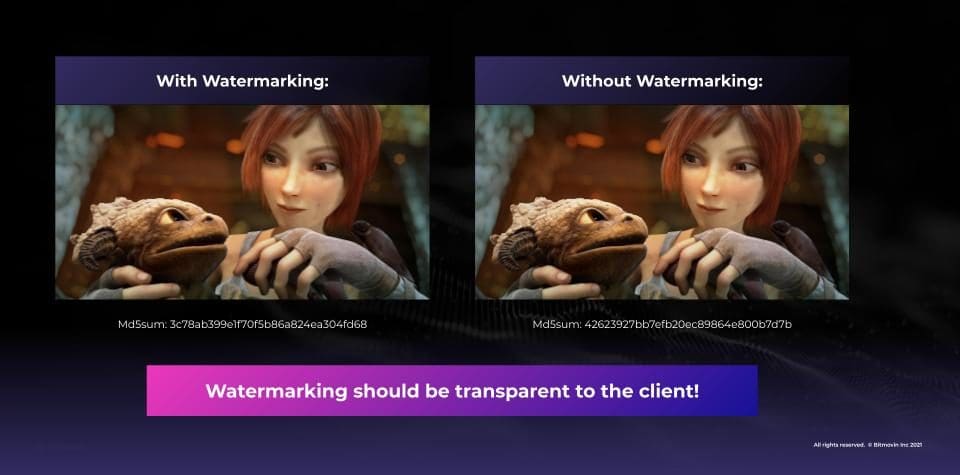Advances in broadband and mobile technologies have made online video consumption an everyday experience for many internet users. Over sixty percent of US households subscribe to a video streaming service and global digital video viewership is on track to reach over three billion viewers by 2023. With this increase in demand, video content needs to be delivered in a way that keeps consumers engaged and without the playback issues that affect user satisfaction. The online video player you choose (or build) should deliver quality content to users quickly and efficiently regardless of the device they use.
In this guide, I’ll explain the characteristics of the ideal online video players and look at the four most critical factors one must to consider—compatibility, compression, content protection, and customization—to help you choose/build the best one.
Compatibility
Online users consume video content through browsers, mobile devices, smart TVs, and streaming devices like Apple TV and Roku, but most devices and platforms won’t support all video formats. For example, Google and Firefox browsers support VP9 and AV1 video codecs, but not HEVC/H.265. Apple’s Safari browser supports HEVC/H.265 but not V9. An incompatible video can cause lines on the screen or distorted output. When producing video content, you’ll want to choose a video format that serves the widest range of platforms and devices for your target market.
What Can an Incompatible Online Video Player Cost You?
Video content that is not compatible with a wide range of devices results in user dissatisfaction, as well as lost opportunities and revenue for your company. According a report by Grandview Research, in 2020, the global video streaming market value stood at $50.11 billion USD. While this was partially due to increased media consumption during the height of the COVID-19 pandemic, enterprises and academic institutions have also realized the benefits of on-demand video content. Corporations are using videos more and more for brand awareness, client engagement, collaboration, and training. In the academic sector, webinars and on-demand courses are being used to enhance the learning process.

While subscriptions are a valuable revenue source for online video content providers, advertising is the major revenue earner. Video has an enormous influence on consumer decisions and spending on digital video ads is expected to reach $12.66 billion by 2024.
Compression
Uncompressed video content is large and difficult to stream over slow internet connections. A single 4K video can take up to 375MB of space for each minute of video. If a video isn’t downloading fast enough, it will stall during playback. Basic video reduction and optimization reduce the size of a video file to prevent playback issues like buffering without vastly affecting video quality. There are two main forms of compression algorithims: lossy and lossless. Lossy compression removes unnecessary repeated images and sounds to create a smaller file, but often results in a lower-quality video. Lossless compression does not reduce data in the compression process and doesn’t result in a significant loss of video quality. The size of the video, however, is not substantially reduced making it a better choice when retaining quality is the primary goal.
Currently Available Compression Standards for Video Content (Codecs)
Let’s consider some of the video compression standards/codecs that are currently in use.
H.264
H.264, also referred to as AVC (Advanced Video Coding) or MPEG-4 AVC, is an industry-standard for video compression developed in 2003 by MPEG and ITU-T VCEG in a partnership called Joint Video Team (JVT). It is the most commonly supported codec for recording, compressing, and distributing video content even with newer codecs emerging. H.264 compression reduces videos by fifty percent over previous formats like MPEG-2, while retaining the same video quality. It supports high-definition videos including 1080p, 4K, and 8k Ultra High Definition, and is widely used in many multimedia industries including broadcasting, live streaming, and video recording.
H.265/HEVC
H.265/HEVC (High-Efficiency Video Encoding) is a standard developed by MPEG and ITU-T VCEG under the JCT-VC partnership between 2013 and 2016. It uses more advanced compression methods than H.264 that allow for higher-quality videos over slower connections. HEVC expands on existing H.264 techniques to improve content compression by thirty-five to fifty-three percent over H.264 while maintaining similar quality. It supports resolutions up to 8192 x 4320 including 8K UHD.
While HEVC uses more advanced technology than H.264, its incompatibility with many platforms and devices and uncertainty about licensing and royalties have hindered its adoption rate.
VP9
VP9 is an open-source, royalty-free codec standardized in 2013 by Google that aims to reduce the bitrate of video transmissions by fifty percent over the previously released V8 codec. VP9 is supported by YouTube and Google’s Chrome browser and is mainly used for streaming videos over the internet. Because VP9 operates under a free BSD license, it can be used for encoding both proprietary and open-source software.
AV1
AV1 was developed by the Alliance for Open Media (AOMedia) in 2015. AOMedia is a joint effort between companies from various industries including Google, Mozilla, and Microsoft, and hardware vendors such as AMD and Intel. AV1 is based on the VP9 codec but provides thirty percent more efficiency. Its key advantage is that it is royalty-free so users avoid licensing headaches.
H.266/VVC
H.266/VVC (Versatile Video Coding) is a new block-based video encoding standard developed by Fraunhofer HHI as part of the Joint Video Experts Team (JVET), which comprises MPEG and ISO/ITU members that include Fraunhofer HHI and Bitmovin. VVC promises fifty percent efficiency over HEVC and seeks to compress large video files like 4K and 8K footage into smaller file sizes for faster transmission. It also provides better support for gaming and screen sharing than preceding codecs. According to Fraunhofer, “H.266/VVC offers faster video transmission for equal perceptual quality.” Bitmovin recently tested this claim.
Content Protection
Video watermarking is a technique used to identify proprietary work, making it more difficult for someone else to claim that work as their own. Video watermarks can be visible or forensic (invisible). A visible watermark can be an embedded overlay on a video comprising a brand logo, website URL, copyright disclaimer, or any other custom watermark. Besides making it easier to recognize unauthorized use of your video, a visible watermark can also promote a product, and increase brand awareness.

Forensic watermarks hide identifying information within the video content and are almost impossible to remove without damaging the video. Since a forensic watermark can only be read by computers, it is a more secure method of protecting video content.
How Digital Rights Management Licensing Workflows Work
Digital Rights Management (DRM) is a digital license system that allows content creators and distributors to control who can use their content and how they can use it. It involves the use of codes to prevent copying or to limit the number of devices that can access the video. A standard DRM licensing workflow involves encoding, packaging, playback, and communication with a licensing server:
Encoding: During this process, the video is encoded using all the codecs you plan to support. Using multiple codecs results in greater device compatibility. The video files are also encrypted with media keys from one or more DRM providers. This process generates keys that lock the encoded content and can only be used by authorized parties to access the video information.
Packaging: After encoding, the video content is packaged and stored in a content delivery network where it is available for streaming. Information in the package lets the player know which codecs are available so that the player can serve the most efficient codec for the specific device and platform.
Playback: When a user attempts to access video content, the player communicates with the DRM licensing server to confirm the user’s license. If the authorization process is successful, the video is unencrypted allowing video playback to begin for the end-user.
License Server: The DRM license server responds to and authenticates decryption requests from the video player every time a user requests video content
Bitmovin has trusted partnerships with several content protection providers and offers out-of-the-box licensing server solutions by Irdeto, EZDRM, BuyDRM, FriendMTS, NAGRA, Vualto, and ExpressPlay.
Customization
The ITU-T (International Telecommunication Union – Telecommunication Standardization Sector) standard defines Quality of Experience (QoE) as “the overall acceptability of an application or service as perceived subjectively by the end-user.” Here are a few features to look for in a customer online video player to improve QoE.
- Customizable Player Interface – using APIs or configuration files to ensure a consistent look and feel across browser-based players, iOS, Android, and smart TVs.
- Multi-Codec and Multi-DRM Support that gives you access to multiple codecs including VP9, HEVC, AV1, and AC3, and a variety of DRM technologies for serving content and controlling content access on a wide range of devices.
- Featured Ad Support for monetization and easy integration with advertising solutions such as Server-Side Ad Insertion, Google IMA, and ad water falling.
- Adaptive Bitrate (ABR) Technology for serving content to several screen sizes and improving start-up times with low bitrate streaming until the player establishes bandwidth capacity.
- Analytics to analyze user behavior to discover new trends and tweak technology and techniques for user satisfaction.
A customizable online video player with features that promote greater compatibility and higher-quality content will improve user experience and satisfaction and increase device reach.
Conclusion
Now that you know all of the factors to consider when choosing an online video player, how do you find the right one for your specific use case? Bitmovin Video Player’s easy-to-use services and APIs give you complete control over your video streams. It provides your viewers with fast start-ups, smooth playback, and compatibility across multiple browsers, operating systems, and devices. It’s a great place to start, and scores highly in all of the relevant factors.
To find out how Bitmovin’s Video Player works, contact one of our experts.



